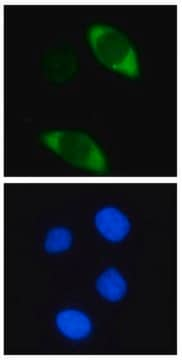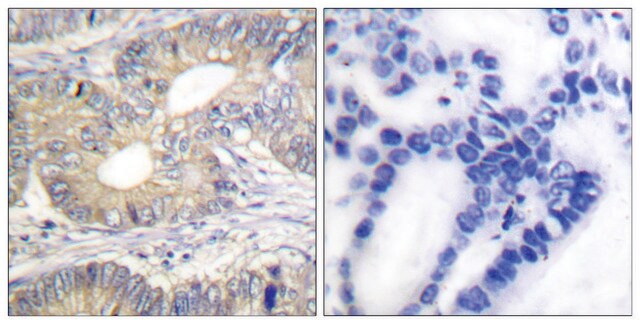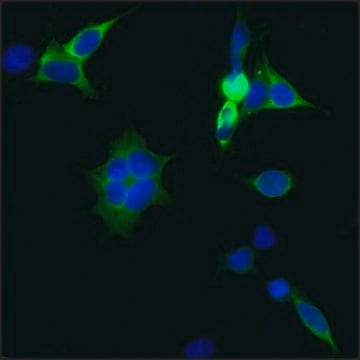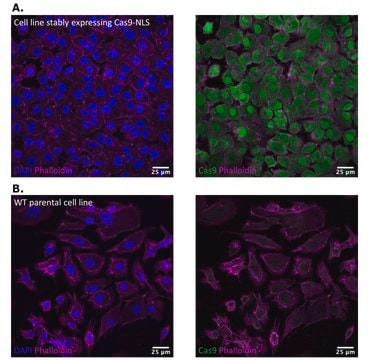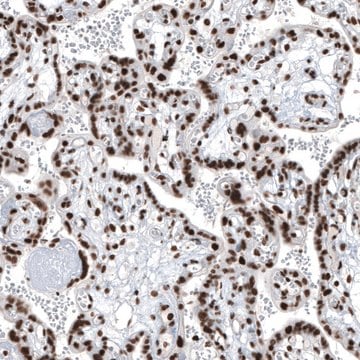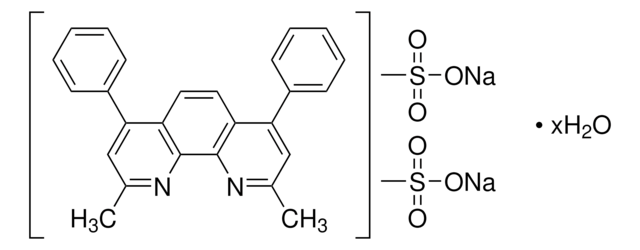SAB4200701
Anti-CRISPR/Cas9 antibody, Mouse monoclonal
clone 7A9-3A3, purified from hybridoma cell culture
Sinónimos:
CRISPR-associated protein-9 nuclease, Crisper, Crispr RNA
About This Item
Productos recomendados
origen biológico
mouse
Nivel de calidad
forma del anticuerpo
purified from hybridoma cell culture
tipo de anticuerpo
primary antibodies
clon
7A9-3A3, monoclonal
formulario
buffered aqueous solution
envase
antibody small pack of 25 μL
concentración
~1 mg/mL
técnicas
immunoblotting: 1-2 μg/mL using whole extracts of human HEK-293T cells over-expressing CAS9 protein
immunofluorescence: 1-2 μg/mL using human HEK-293T cells over-expressing CAS9 protein.
immunoprecipitation (IP): 5-10 μg using whole extract of human HEK-293T cells over-expressing CAS9 protein
isotipo
IgG1
Condiciones de envío
dry ice
temp. de almacenamiento
−20°C
modificación del objetivo postraduccional
unmodified
Descripción general
The Cas9 endonuclease can be engineered with a single gRNA, directing a DNA double-strand break (DSB) at a desired genomic location. Similar to DSBs induced by zinc finger nucleases (ZFNs), the cell then activates endogenous DNA repair processes, either non-homologous end joining (NHEJ) or homology-directed repair (HDR), to heal the targeted DSB. In comparison to other genome-editing technologies such as designer zinc fingers (ZFs), transcription activator–like effectors (TALEs) and homing meganucleases, the CRISPR/CAS9 system is a scalable, affordable and easy to engineer. Therefore, the anti-CRISPR/CAS9 antibody can be a useful tool for detecting CRISPR/CAS9 positively transfected cells, reveling DSB sites in the genome and in ChIP (Chromatin Immunoprecipitation) related assays.
Inmunógeno
Aplicación
Acciones bioquímicas o fisiológicas
Forma física
Almacenamiento y estabilidad
Otras notas
In order to obtain best results in different techniques and preparations we recommend determining optimal working concentration by titration test.
Cláusula de descargo de responsabilidad
Not finding the right product?
Try our Herramienta de selección de productos.
Código de clase de almacenamiento
12 - Non Combustible Liquids
Clase de riesgo para el agua (WGK)
WGK 1
Punto de inflamabilidad (°F)
Not applicable
Punto de inflamabilidad (°C)
Not applicable
Certificados de análisis (COA)
Busque Certificados de análisis (COA) introduciendo el número de lote del producto. Los números de lote se encuentran en la etiqueta del producto después de las palabras «Lot» o «Batch»
¿Ya tiene este producto?
Encuentre la documentación para los productos que ha comprado recientemente en la Biblioteca de documentos.
Los clientes también vieron
Nuestro equipo de científicos tiene experiencia en todas las áreas de investigación: Ciencias de la vida, Ciencia de los materiales, Síntesis química, Cromatografía, Analítica y muchas otras.
Póngase en contacto con el Servicio técnico